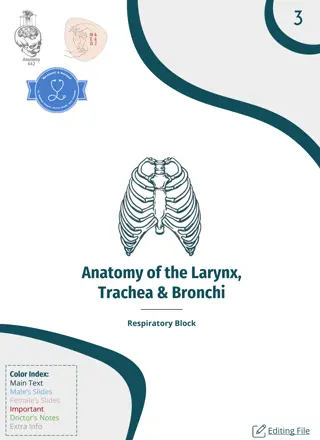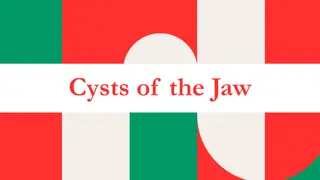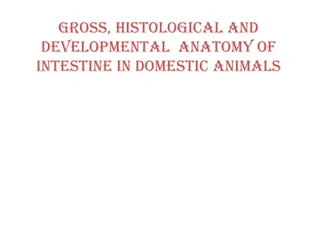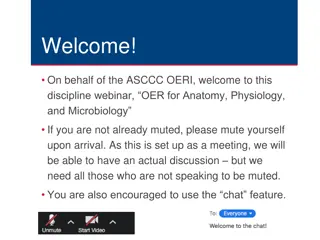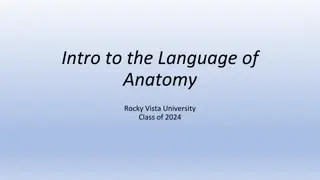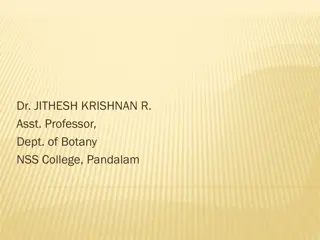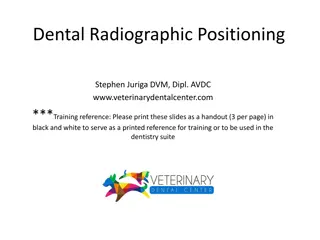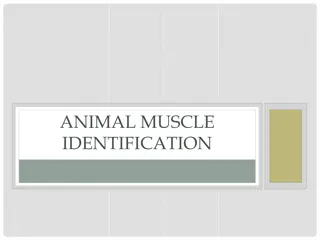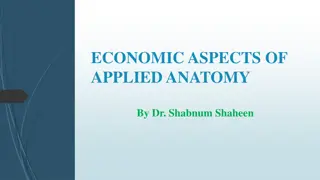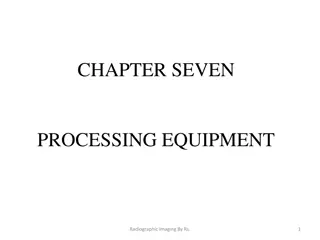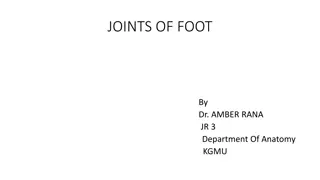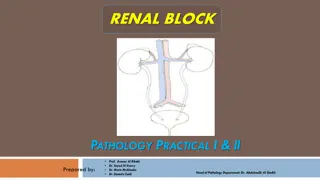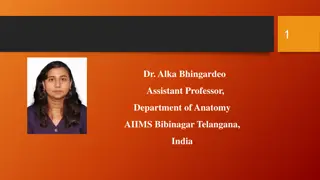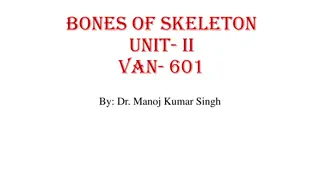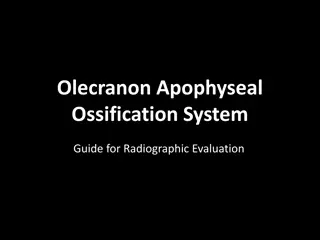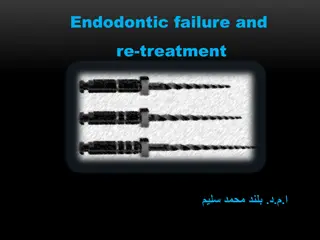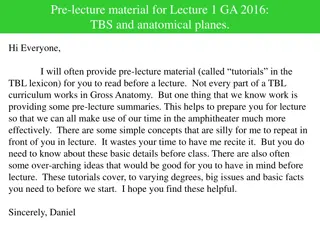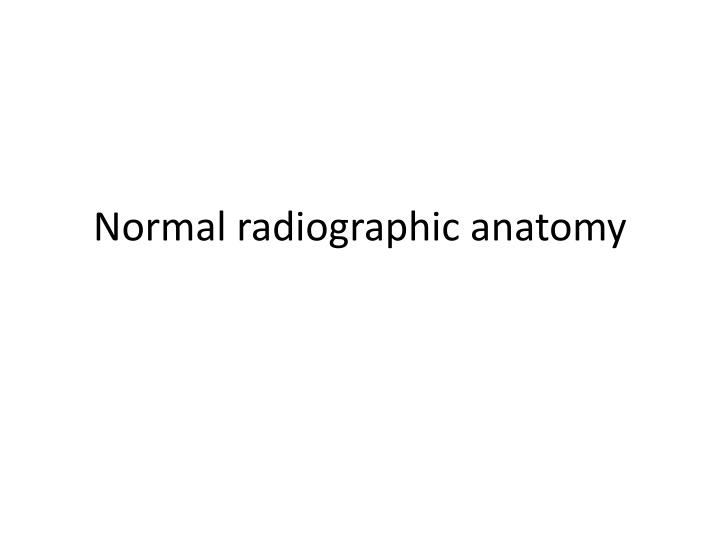
Understanding Normal Radiographic Anatomy in Dentistry
Explore the normal radiographic anatomy in dentistry through detailed descriptions and images of structures such as lamina dura, alveolar crest, periodontal ligament space, and cancellous bone. Learn how these elements vary based on occlusal stress and the presence of periodontal disease.
Download Presentation

Please find below an Image/Link to download the presentation.
The content on the website is provided AS IS for your information and personal use only. It may not be sold, licensed, or shared on other websites without obtaining consent from the author. If you encounter any issues during the download, it is possible that the publisher has removed the file from their server.
You are allowed to download the files provided on this website for personal or commercial use, subject to the condition that they are used lawfully. All files are the property of their respective owners.
The content on the website is provided AS IS for your information and personal use only. It may not be sold, licensed, or shared on other websites without obtaining consent from the author.
E N D
Presentation Transcript
Lamina dura Tooth sockets are bounded by a thin r opaque layer of dense bone This layer is continuous with the shadow of cortical bone at the alveolar crest It is only slightly thicker and no more highly mineralized than the trabeculae of cancellous bone in the area r/g appearance is due to the fact that x ray beam passes tangentially through many times the thickness of thin bony wall, which results in observed attenuation
Thickness and density of lamina dura vary with the amount of occlusal stress on the tooth It is more wider and more dense around the roots of teeth in heavy occlusion and thinner and less dense when subjected to no occlusal function
Alveolar crest Gingival margin of alveolar process that extends b/w the teethis apparent as a r opaque line, the alveolar crest Level of the crest is normal when it is not more than 1.5mm from CEJ of adjacent teeth In anterior region, crest is reduced to only a point of bone b/w close set incisors Posteriorly, it is flat, aligned parallel with and slightly below a line connecting CEJ of adjacent teeth Crest of bone is continuous with lamina dura and forms a sharp angle with it Rounding of these sharp junctions is indicative of periodontal disease
Periodontal ligament space It appears as a radiolucent space b/w the tooth root and lamina dura This begins at alveoalr crest, extends around the portions of tooth roots within the alveolus and returns to the alveolar crest on opposite side of tooth It is thinner in middle of the root and slightly wider near alveolar crest and root apex
Cancellous bone Lies b/w cortical plates in both jaws It is composed of thin r opaque plates and rods surrounding many small r lucent pockets of marrow Trabeculae in anterior maxilla are thin and numerous forming a fine, granular, dense pattern and marrow spaces are small and relatively numerous In posterior maxilla, similar to anterior maxilla, but marrow spaces are slightly larger In anterior mandible, trabeculae are somewhat thicker than in maxilla, resulting in a coarser pattern with trabecular plates oriented more horizontally
Trabecular plates are also fewer than in the maxilla and marrow spaces are larger In posterior mandible, periradicular trabeculae and marrow spaces are comparable to anterior mandible but are somewhat larger Trabeculae plates are oriented more horizontally here Below the apices of mandibular molars the no of trabeculae dwindles still more
Maxilla Intermaxillary suture Anterior nasal spine Nasal fossa Incisive foramen Superior formina of nasoplaltine canal Lateral fossa Nose Nasolacrimal canal Maxillary sinus Zygomatic process and zygomatic bone Nasolabial fold Pterygoid plates
Intermaxillary suture Also called median suture Appears as a thin r lucent line in the midline b/w 2 portions of the premaxilla It extends from the alveolar crest b/w central incisors superiorly through the anterior nasal spine and continues posteriorly b/w maxillary palatine processes to the posterior aspect of hard palate This narrow r lucent suture terminates at the alveoalr crest in a small rounded or V shaped enlargement This is bordered by radiopaque borders of thin cortical bone on each side of maxilla This r lucent region is usually of uniform width
Anterior nasal spine Located in the midline, it lies some 1.5 to 2 cm above the alveolar crest, usually at or just below the junction of inferior end of nasal septum and the inferior outline of nasal fossa It is r opaque and is usually V shaped
Nasal fossa Inferior border of fossa appears as a r opaque line extending bilaterally away from the base of ANS Above this line is a r lucent space of inferior portion of fossa Nasal cavity contains the hazy shadows of inferior conchae extending from right and left lateral walls for varying distances toward the septumthese conchae fill varying amounts of lateral portions of fossa
Incisive foramen Syn: nasopalatine or anterior palatine foramen Is the oral terminus of nasopalatine canal It transmits the nasopalatine vessels and nerves it is usually projected b/w the roots and in the region of middle and apical thirds of central incisors It may appear smoothly symmetric, with numerous forms or very irregular with a well demarcated or ill defined border It is site for cyst formation Presence of cyst is presumed if the width of foramen exceeds 1cm Lateral walls of nasopalatine canal appears as a pair of r opaque lines running vertically from superior formina of canal to incisive foramen
Superior formina of the nasopalatine canal Originates at 2 formina in the floor of nasal cavity Openings are on each side of nasal septum, close to anteroinferior border of nasal cavity, and each branch passes downward somewhat anteriorly and medially to unite with the canal from the other side in a common opening, incisive foramen Is seen when exaggerated vertical angle is used Appear as 2 r lucent areas above the apices of central incisors in the floor of nasal cavity near its anterior border and on both sides of septum Are usually round or oval
Lateral fossa Syn: incisive fossa Is a gentle depression in maxilla near the apex of lateral incisor Appears as diffusely radiolucent
Nose Soft tissue of the tip of the nose is frequently seen in projections of central and lateral incisors, superimposed over roots of these teeth Appears as a uniform, slightly opaque appearance with a sharp border
Nasolacrimal canal Nasal and maxillary bones form the nasolacrimal canal It runs from the medial aspect of the anteroinferior border of the orbit inferiorly, to drain under inferior conchae into the nasal cavity Ocasionally can be visualised above the apex of canine, splly when steep angle is used in IOPA
Maxillary sinus Is an air containing cavity lined with mucous membrane Borders of sinus appears as a thin, delicate, tenous r opaque line Extend from distal aspect of canine to posterior wall of maxilla above the tuberosity Anteriorly, each sinus is restricted by canine fossa and is usually seen to sweep superiorly, crossing the level of floor of nasal cavity in premolar or canine region In IOPA of canine, floor of sinus and nasal cavity are often superimposed and may be seen crossing one another, forming an inverted Y in the area
Degree of extension of sinus into alveolar process is extremely variable In some, floor of sinus will be well above apices of posterior teeth, in others it may extend well beyond the apices toward the alveolar ridge In edentulousness, sinus may expand further into alveolar bone, occasionally extending to alveolar ridge Root apices may project anatomically into floor of sinus, causing small elevations or prominences Thin layer of bone covering the root is seen as a fusion of lamina dura and floor of sinus
Ropaque lines traverse the image of sinus and represents folds of cortical bone projecting a few mm away from floor and wall of antrum They are usually oriented vertically Floor of sinus occasionally shows r opaque projections, which are nodules of bone, and show trabeculation
Zygomatic process and zygomatic bone Zy process of maxilla is an extension of lateral maxillary surface that arises in the region of apices of 1stand 2ndmolars and serves as articulation for zy bone Process appears as U shaped r opaque line with its open end directed superiorly Identified as a uniform gray or white r;opacity over the apices of molars
Nasolabial fold An oblique line demarcating a region that appears to be covered by a veil of slight r opacity frequently traverses IOPA of premolar region Line of contrast is sharp, and area of increased r opacity is posterior to the line Opaque veil is a thick cheek tissue superimposed on teeth and alveolar process
Pterygoid plates Medial and lateral pterygoid plates lie immediately posterior to tuberosity of maxilla Image is extremely variable They always cast a single r opaque homogenousshadow without any evidence of trabeculation Extending inferiorly from medial pterygoid plate may be seen the hamular process, which on close inspection can show trabeculation
Mandible Symphysis Genial tubercles Mental ridge Mental fossa Mental foramen Mandibular canal Nutrient canals Mylohyoid ridge Submandibular gland fossa External oblique ridge Inferior border of the mandible Coronoid process
Symphysis In infants demonstrate a r lucent line through the midline of jaw b/w images of forming deciduous central incisors This suture usually fuses by end of 1styear of life If this r lucency is found in adults, it represents cleft or fracture
Genial tubercles Syn: mental spine Are located on the lingual surface of mandible slightly above the inferior border and in the midline They are bony protuberances, more or less spine shaped Are seen on occlusal projections as one or more small projections On IOPA, appear as 3-4mm r opaque mass in midline below incisor roots
Lingual foramen It contains the termination of incisive branch of mandibular canal Is seen as a r lucent dot surrounded by its cortical wall
Mental ridge On IOPA, is seen as 2 r opaque lines sweeping bilaterally forward and upward toward the midline Are of variable width and density and seen extending from low in premolar region to each side up to midline
Mental fossa Is a depression on labial aspect of mandible extending laterally from midline and above the mental ridge
Mental foramen Is usually the anterior limit of inferior dental canal It appears as oblong, round, slitlike or very irregular and partially or completely corticated Is located about halfway b/w lower border of mandible and crest of alveolar process in region of 2ndpremolar
Mandibular canal Image is that of a dark linear shadow with thin r opaque superior and inferior borders casst by the lamella of bone that bounds the canal Relationship of mandibular canal to the roots of lower teeth may vary close contact with all molars to one in which there is no intimate contact with posteriors
Nutrient canals Carry neurovascular bundle and appear as r lucent lines of fairly uniform width Seen on mandibular periapical r/g running vertically from inferior dental canal directly to the apex of a tooth or into the interdental space b/w mandibular incisors More frequent in blacks, males, older persons and individuals with high blood pressure or advanced periodontal disease

